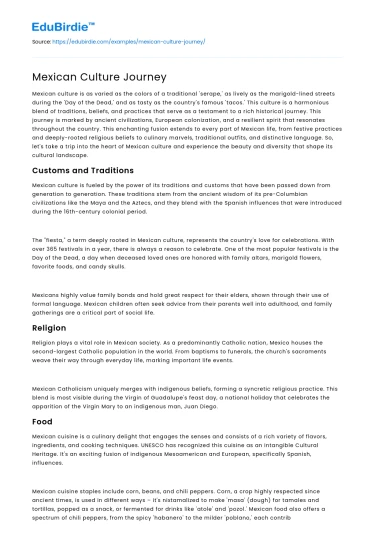Mexican culture is as varied as the colors of a traditional 'serape,' as lively as the marigold-lined streets during the 'Day of the Dead,' and as tasty as the country's famous 'tacos.' This culture is a harmonious blend of traditions, beliefs, and practices that serve as a testament to a rich historical journey. This journey is marked by ancient civilizations, European colonization, and a resilient spirit that resonates throughout the country. This enchanting fusion extends to every part of Mexican life, from festive practices and deeply-rooted religious beliefs to culinary marvels, traditional outfits, and distinctive language. So, let's take a trip into the heart of Mexican culture and experience the beauty and diversity that shape its cultural landscape.
Customs and Traditions
Mexican culture is fueled by the power of its traditions and customs that have been passed down from generation to generation. These traditions stem from the ancient wisdom of its pre-Columbian civilizations like the Maya and the Aztecs, and they blend with the Spanish influences that were introduced during the 16th-century colonial period.
Save your time!
We can take care of your essay
- Proper editing and formatting
- Free revision, title page, and bibliography
- Flexible prices and money-back guarantee
The "fiesta," a term deeply rooted in Mexican culture, represents the country's love for celebrations. With over 365 festivals in a year, there is always a reason to celebrate. One of the most popular festivals is the Day of the Dead, a day when deceased loved ones are honored with family altars, marigold flowers, favorite foods, and candy skulls.
Mexicans highly value family bonds and hold great respect for their elders, shown through their use of formal language. Mexican children often seek advice from their parents well into adulthood, and family gatherings are a critical part of social life.
Religion
Religion plays a vital role in Mexican society. As a predominantly Catholic nation, Mexico houses the second-largest Catholic population in the world. From baptisms to funerals, the church's sacraments weave their way through everyday life, marking important life events.
Mexican Catholicism uniquely merges with indigenous beliefs, forming a syncretic religious practice. This blend is most visible during the Virgin of Guadalupe's feast day, a national holiday that celebrates the apparition of the Virgin Mary to an indigenous man, Juan Diego.
Food
Mexican cuisine is a culinary delight that engages the senses and consists of a rich variety of flavors, ingredients, and cooking techniques. UNESCO has recognized this cuisine as an Intangible Cultural Heritage. It's an exciting fusion of indigenous Mesoamerican and European, specifically Spanish, influences.
Mexican cuisine staples include corn, beans, and chili peppers. Corn, a crop highly respected since ancient times, is used in different ways – it's nixtamalized to make 'masa' (dough) for tamales and tortillas, popped as a snack, or fermented for drinks like 'atole' and 'pozol.' Mexican food also offers a spectrum of chili peppers, from the spicy 'habanero' to the milder 'poblano,' each contributing its unique heat and flavor.
The exploration of Mexican cuisine introduces us to iconic dishes. Tacos, perhaps the most internationally known Mexican food, are tortillas filled with various ingredients like meats, cheese, beans, and salsas. 'Mole,' a traditional marinade and sauce, captures the complexity of Mexican cuisine with its blend of chili peppers, spices, fruits, and often, chocolate.
Beyond its ingredients and dishes, Mexican cuisine shows a deep respect for cooking and communal eating. Home-cooked meals, prepared with love, are frequently shared with family and friends, highlighting the societal significance of communal meals. From modest family kitchens to busy food markets and upscale restaurants, Mexico's food culture celebrates its rich heritage, regional diversity, and strong sense of community.
Clothing
Just like its culture, Mexican clothing is a dynamic blend of historical tradition and contemporary fashion. Traditional outfits, deeply rooted in Mexico's pre-Hispanic and colonial history, differ considerably across regions, each with its unique patterns, materials, and garments. One of the most recognized items is the 'serape,' or 'poncho,' a brightly colored, often striped cloak from northern Mexico. Made from wool, serapes feature geometric patterns and are used for warmth or as clothing.
For women in central and southern Mexico, the 'huipil' is a traditional attire. This loose tunic, made of cotton or wool, is beautifully decorated with intricate designs. The patterns, often hand-embroidered, represent the local culture and environment of the weaver.
However, contemporary Mexican fashion is not limited to traditional garments. Modern Mexican style reflects global trends, with jeans, t-shirts, dresses, and suits common in urban areas. Nonetheless, traditional elements often make their way into contemporary fashion, whether through indigenous textile patterns on modern shapes or handmade jewelry pieces complementing everyday outfits.
Slang
Mexican slang, or "jerga," is a vibrant and expressive part of the Spanish language. It adds color, humor, and local flair to conversations, mirroring the vibrant spirit of Mexican culture. From casual talks with friends to street interactions, Mexican slang brings warmth and a sense of camaraderie to daily conversations.
One frequently used phrase in Mexican slang is "¿Qué onda?" which translates to "What's up?" This casual greeting invites friendly conversation and sets a relaxed tone. Another popular slang term is "chido" or "padre," meaning "cool" or "awesome." It's often used to express admiration or approval.
Conclusion
Mexican culture is a harmonious blend of diverse influences, dynamic traditions, and deeply ingrained values. It's a culture that resonates with the energy of its lively festivals, the aroma of its mouth-watering food, the variety of its traditional clothing, and the warmth of its people. As we understand and appreciate its intricacies, we begin to recognize the significant cultural contribution that Mexico makes on a global scale.






 Stuck on your essay?
Stuck on your essay?

